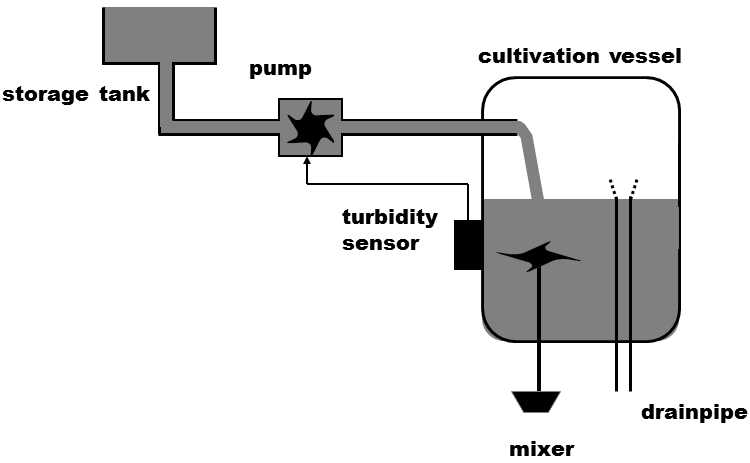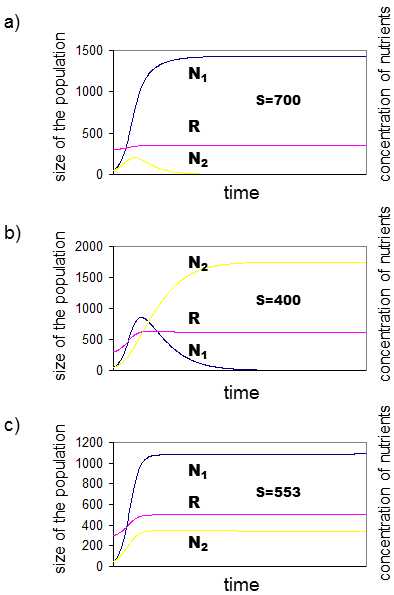IV.3.1 The existence of two distinct r- and K-strategies might be related to the existence of two types of negative feedback regulating the size of the population.
IV.3.1 The existence of two distinct r- and K-strategies might be related to the existence of two types of negative feedback regulating the size of the population.
Although the death rate and the rate of reproduction of organisms in time vary very irregularly and very strongly, from the long-term perspective, the sizes of the populations of the individual species remain constant. This long-term stability can be ensured only by the existence of some kind of negative feedback regulating the size of the population and compensating random effects of the varying intensities of reproduction and death. In principle, there can be only two types of this feedback and technical laboratory models exist for both types (Flegr 1997 ) (Fig. IV.3). The first of

Fig. IV.3. Turbidostat and chemostat. The equipment in the figure can work either in the regime of a turbidostat or in the regime of a chemostat. If the medium flowing from the stock vessel contains a low concentration of a certain nutrient, the population growth is limited by the concentration of this nutrient in the cultivation vessel and the equipment works in the regime of a chemostat. If the size of the population increases for any reason, the concentration of the limiting nutrient decreases in the cultivation vessel, the rate of multiplication of the organisms decreases and the size of the population decreases. The decrease in the population leads to a subsequent increase in the concentration of nutrients, to an increase in the rate of multiplication and thus to an increase in the population. In the turbidostat regime, the concentration of nutrients in the inflowing medium is high, so that it does not limit the rate of growth. The size of the population, to be more exact, the turbidity (scattering and absorption of light passing through the cultivation vessel) is, however, constantly monitored by an optical sensor that, in dependence on the actual turbidity, increases the flow rate of the medium through the vessel. If the size of the population increases for some reason, the turbidity of the medium in the cultivation vessel increases, the flow rate of the medium also increases and thus there is an increase in the flow of nutrients into the vessel,together with an increase in the rate of flushing the organisms out of the cultivation vessel. The increased rate of flushing out of the organisms leads to a decrease in the size of the population, a reduction in the turbidity and thus also a reduction in the rate of flushing organisms out of the vessel.
these, “top-down regulation”, can be modeled in the laboratory in continuous cultivation systems of the turbidostat type. In this system a sensor (mostly optical) monitors the size of the population and, when it increases, the instrument increases the flow of nutrient medium through the cultivation vessel and thus increases the rate of flushing organisms out of the vessel. Thus, an increase in the population increases the rate at which individuals are flushed out of the vessel, subsequently leading to reduction in the size of the population to the original value. In nature, negative feedback of the turbidostat type is functional for systems in which an increase in the population leads to an increase in the death rate of its members. This occurs, e.g., in populations in which the size of the population of prey is regulated by the activity of predators. An increase in the number of prey leads to an increase in the number of predators, leading to increased predation and thus to a decrease in the size of the population of prey (and subsequently to a decrease in the size of the population of predators). Similar negative feedback exists in systems in which the size of the population is regulated by the action of an infectious agent (a contagious disease, a parasite). In this case, the effectiveness of spreading of an infectious agent is frequently directly proportional to the number of contacts between members of the population and the frequency of these contacts is directly proportional to the density of the population of hosts or, to be more precise, to the square of the population density.
The second type of negative feedback, “bottom-up-regulation” is modelled in continuous cultivation systems of the chemostat type. In these systems, nutrient medium flows into the cultivation vessel at a constant rate. If the population increases, nutrients are consumed more rapidly from the medium, their concentration decreases, the organisms begin to suffer from a lack of nutrition and the rate of reproduction is reduced. Thus, the natural death rate predominates over the rate of reproduction and the size of the population begins to decrease, the consumption of nutrients also decreases and the rate of reproduction of the population increases again. In nature, this type of negative feedback occurs everywhere where the size of the population is limited (and regulated) by the amount of some resource. For example, the population of predators in the previous case is limited by the size of the population of prey; however, a population can be similarly limited by any scarce resource, such as the number of available hiding places. In case of regulation of the population by lack of hiding places, the “superfluous individuals” are finally eliminated by predators, but the primary reason for their superfluousness is that lack of a resource (hiding places) and thus the growth of the population are regulated by negative feedback of the chemostat type.
The type of negative feedback determines which of the parameters of the organism will decide on the success of the individual and thus which will be the subject of natural selection. It follows from theoretical analysis (Flegr 1997) that the maximum rate of reproduction is the critical parameter in systems of the turbidostat type, e.g., the number of glucose molecules that the organism is capable of converting to biomass per time unit in the presence of an excess of all resources. In contrast, in systems of the chemostat type, the critical parameter is the effectiveness of utilization of a limiting resource, thus, e.g., the number of ATP molecules that a given individual is capable of forming from one glucose molecule (Fig. IV.4). Recalling the properties of r-strategists and K-strategists in the previous part, it can be seen that the properties of r-strategists, i.e. greater rate of reproduction, shorter life cycle, greater number of not very fit progeny, poor ability to compete with other species in stabilized biotopes, can be interpreted as the result of selection for the maximum rate of reproduction under turbidostatic conditions, while the opposite properties of K-strategists can be interpreted as being a result of selection for maximum effectiveness utilizing a limiting resource. This means that the long-known existence of two distinct ecological strategies could be related to the existence of two, and only two, types of negative feedback capable of maintaining a constant size of the population.

Fig. IV.4. Competition in a turbidostat and chemostat In the equipment in Fig. IV.3, two kinds of organisms can compete together (e.g. a mutant and the parent population), where the parent population N1 has a higher maximum growth rate r1 and simultaneously lower effective use of resources k1 compared to the mutant population N2. Thus, if the concentration of nutrients in the inflowing medium S is high, the parent population wins in the competition (a); if it is low, the mutant is more successful (b). However, there is a range of nutrient concentrations that permits the parent population to be regulated chemostatically and the mutant turbidostatically. The two populations can coexist permanently at this concentration (c). Model:
dN1/dt = N1 [min(r1,RIk1) –D(N1+N2) ],dN2/dt =N2 [min (r2,RIk2)- D(N1+N2)],dR/dt= D(N1+N2)S-D(N1+N2)R-N1 min(r1/k1,RI)-N2min(r2/k2,RI),
where R is the concentration of nutrients in the cultivation tank, I is the rate of input of nutrients into the organism, and D is the flush-out constant – a technically adjustable parameter of the equipment determining the dependence of the pump rate on the measured turbidity (Flegr 1997).
